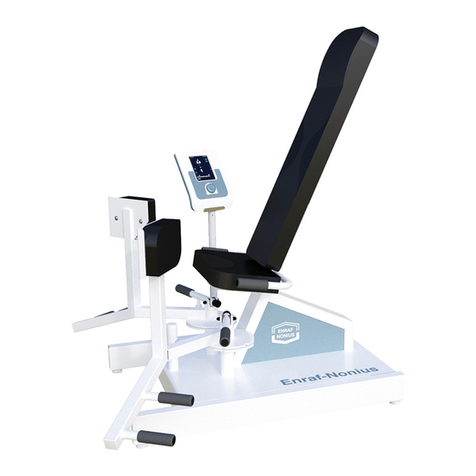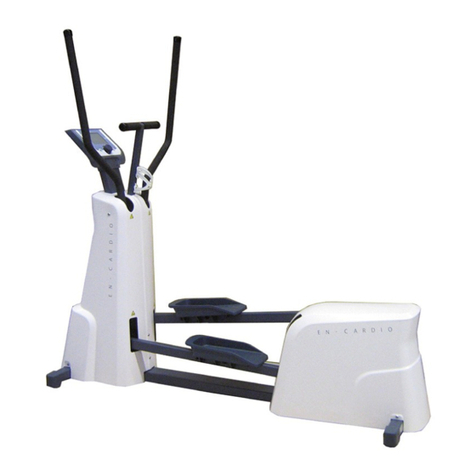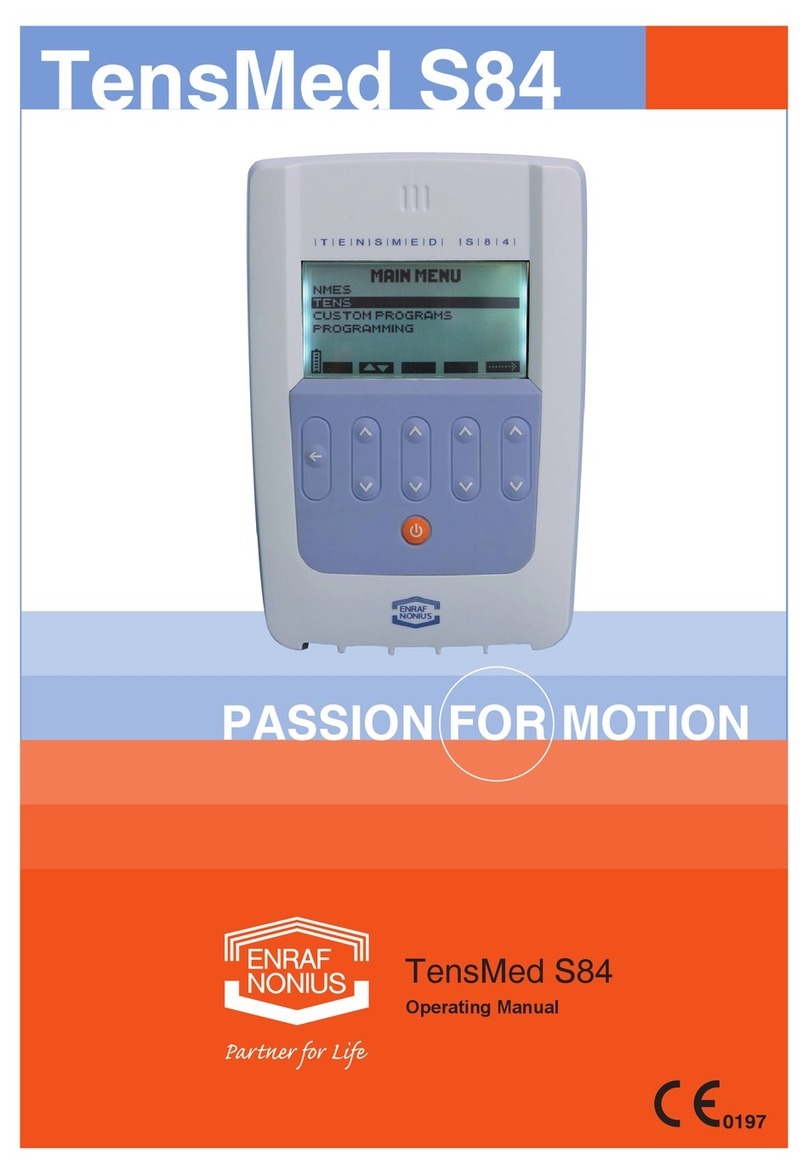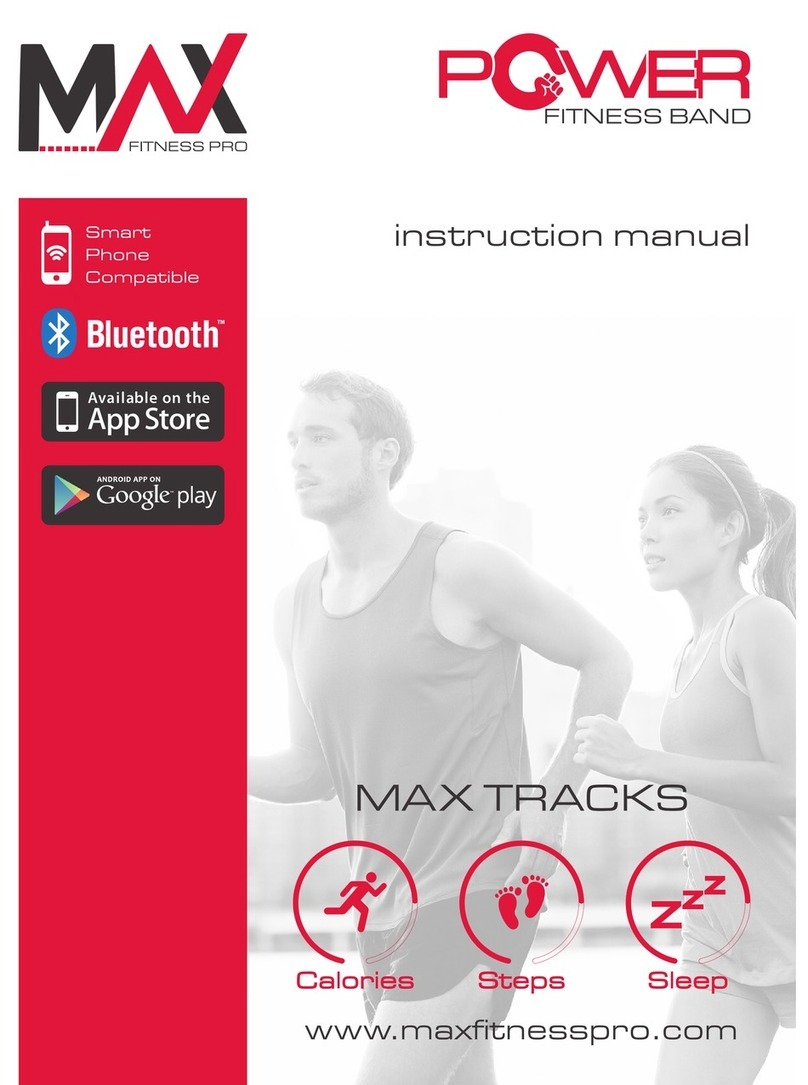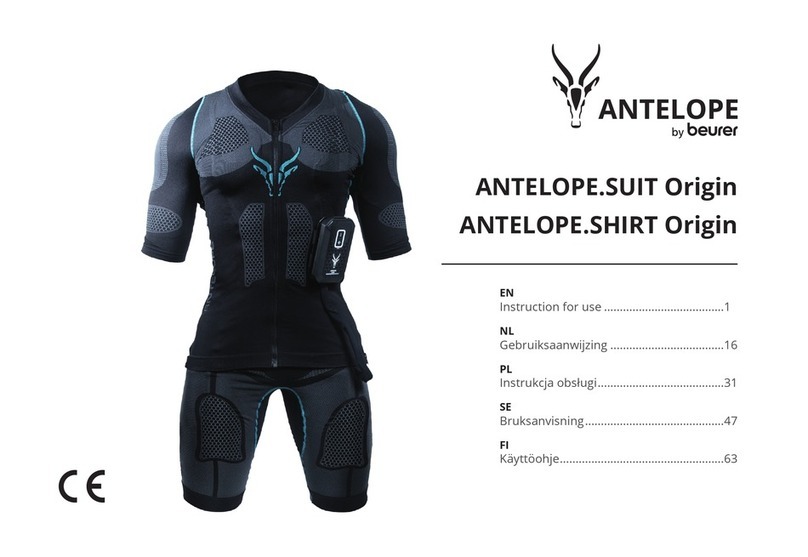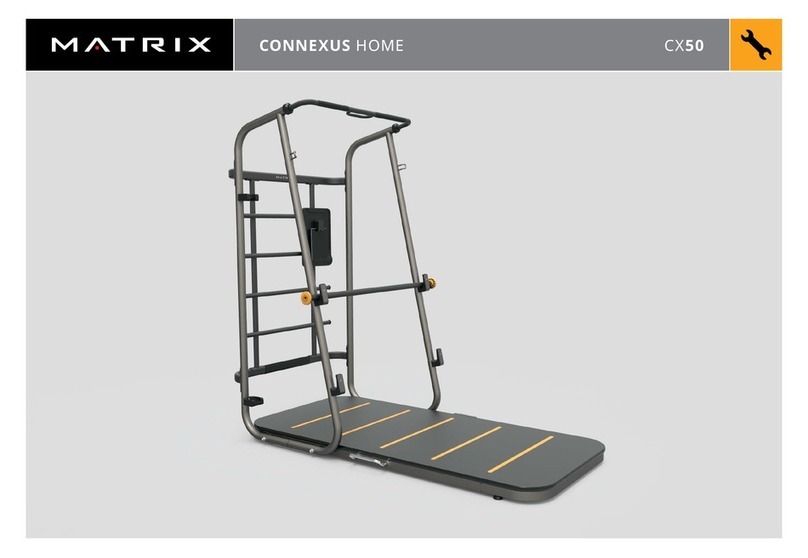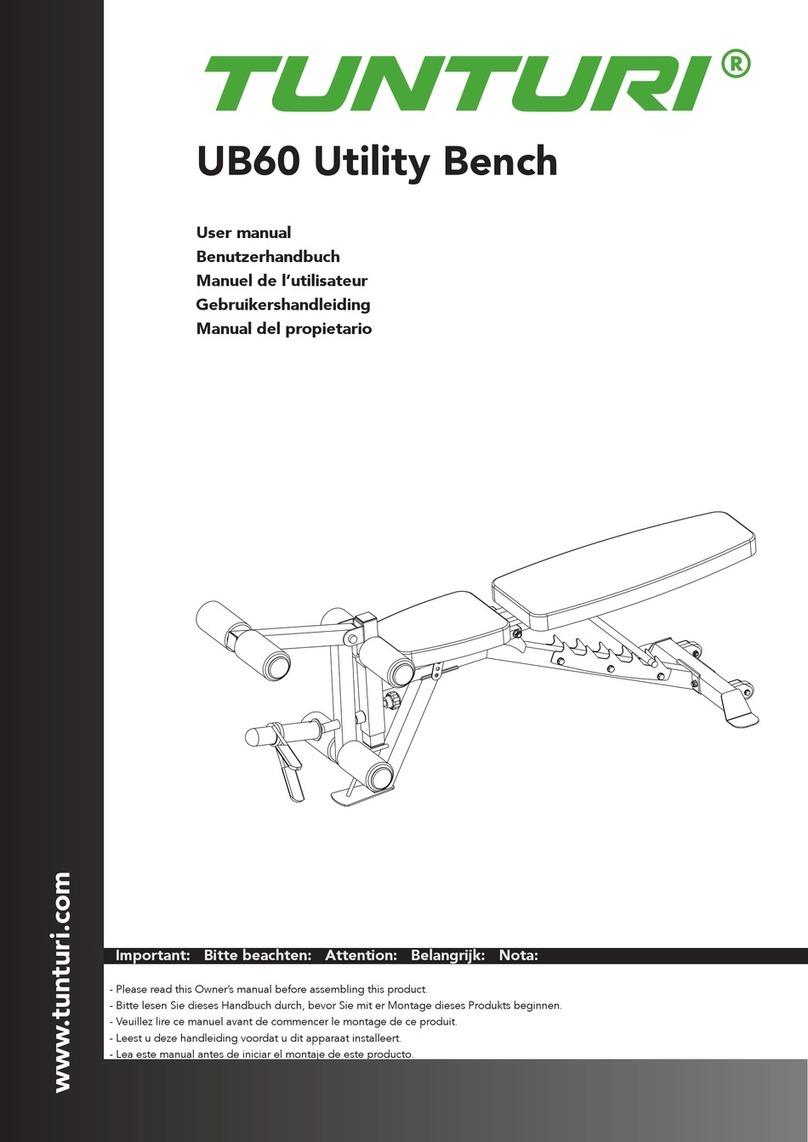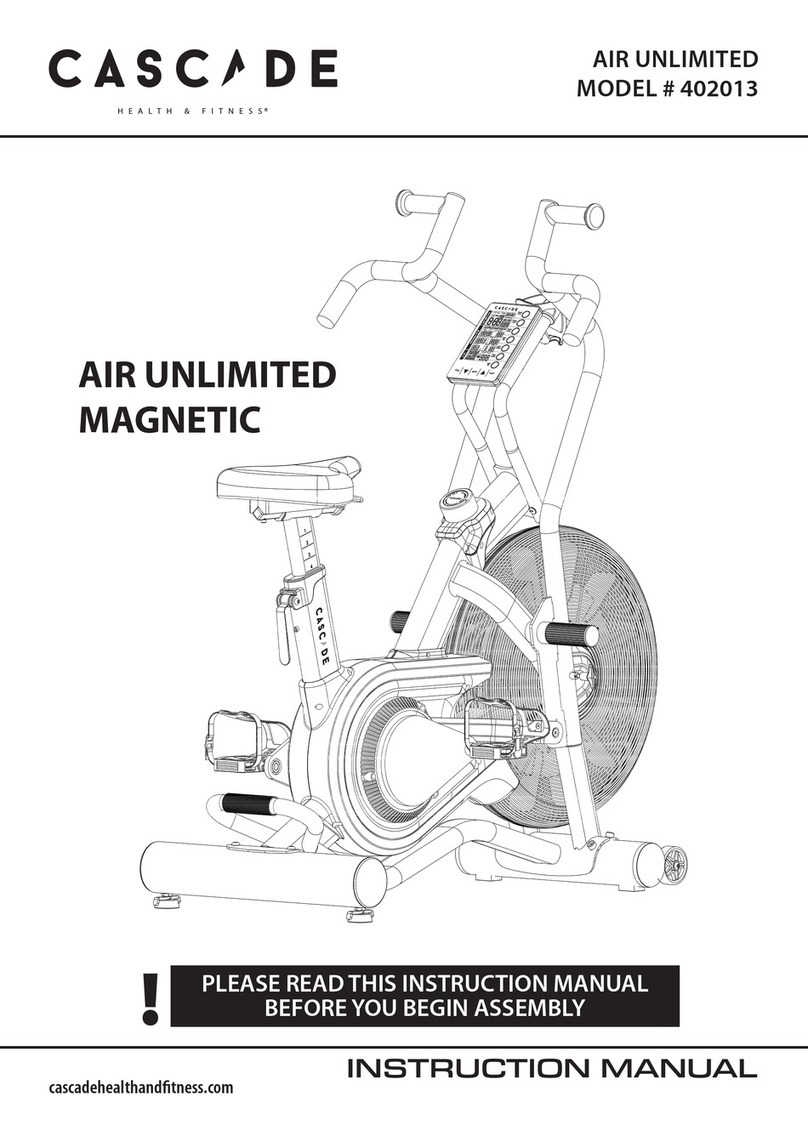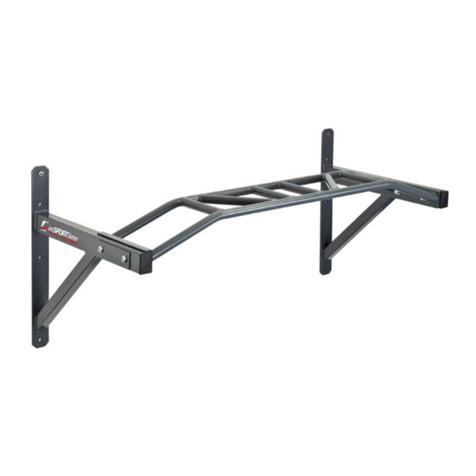Enraf Nonius BIKE REHA User manual

EN109-1413760-47 IFU
BIKE REHA
Instructions for Use
Part number: EN109-1413760-47 IFU
January 4, 2021

Page 2 of 30 EN109-1413760-47 IFU
TABLE OF CONTENTS
1INTRODUCTION.............................................................................................................................................................3
2SYMBOLS..........................................................................................................................................................................4
3PACKAGE CONTENTS .................................................................................................................................................. 5
4SETUP.................................................................................................................................................................................6
5USING THE DEVICE....................................................................................................................................................... 7
6OPERATION ...................................................................................................................................................................12
7MAINTENANCE ............................................................................................................................................................25
8ORDERING INFORMATION .....................................................................................................................................26
9SPECIFICATIONS..........................................................................................................................................................27
10 PRODUCT LIABILITY ...................................................................................................................................................28

Page 3 of 30 EN109-1413760-47 IFU
1INTRODUCTION
Thank you for purchasing the Enraf-Nonius Bike Reha.
This bicycle ergometer is intended for stationary cycling and to help you treat patients in the field of
physical medicine and rehabilitation.
We hope that this will be a valuable device in the execution of your profession and that it will improve
the health and quality of life of many people.

Page 4 of 30 EN109-1413760-47 IFU
2SYMBOLS
Follow the instructions in the Instructions for Use.
It is important that you read, understand and observe the precautionary and operating
instructions
Warning:
Indicates that there is a certain form of danger.
Describes the dangers that can lead to personal injury or death.
Caution:
Indicates that there is a certain form of danger.
Describes the dangers that can lead to damage to a product, including the chance of data
loss.
Product is in conformity with the European Union Medical Device Regulation (EU)
2017/745.
Name and contact information of the manufacturer and production date.
Reference or model number
Serial number, used for identification of the device.
Indicates that the item is a medical device.
Indicates a carrier that contains Unique Device Identifier information
Indicates Type B applied parts.
No electrical contact with Patient and may be earthed.
Indicates the range of atmospheric pressure to which the medical device can be safely
exposed.
Indicates the range of humidity to which the medical device can be safely exposed.
Indicates the temperature limits to which the medical device can be safely exposed.
This is an electronic or electrical device. Dispose of this product according to local
regulations. This will help to recycle
Fuse properties
2x T6.3 250VAH

Page 5 of 30 EN109-1413760-47 IFU
3PACKAGE CONTENTS
With your Bike Reha (art.nr. 1413921) or Bike Reha with adjustable cranks (art.nr. 1413922) you will
find enclosed:
1x 1413768 Instructions for Use (PDF on CD)
1x 1413764 Information Booklet
1x 3444298 Power cord
Alternating current
Emergency stop button
Use of accessories and cables other than those specified or provided by the manufacturer of
this equipment is NOT allowed.

Page 6 of 30 EN109-1413760-47 IFU
4SETUP
No specific installation activities are required that would require the assistance of a technician
authorized by Enraf-Nonius.
UNPACKING
The unit weighs approximately 55 kg.
We advise you to unpack the device with at least 2 persons.
INSPECTION
Immediately upon unpacking the unit, check if the package contains all items listed above in the
package contents and check the device for any damage.
SETUP
Level the device by adjusting the rubber feet for optimal stability.
The connection for the mains cable is located at the rear, on the underside of the frame.
After the mains cable has been connected, switch on the device by using the switch located next to
the mains cable connection.
The Bike Reha is now ready for use.
In case of damage, contact your local distributor. Do NOT use the device!
To avoid the risk of electric shock, this equipment must only be connected to a mains supply
with protective earth.
No unauthorized modification of this equipment is allowed.
Check the technical data section to make sure the mains supply complies with the technical
specifications of the device.
Check the technical data section to make sure the environment complies with the
environmental conditions for use of the device.
Do not install the device next to a heat source or in “wet-rooms” or hydrotherapy rooms
Avoid exposure to direct sunlight.

Page 7 of 30 EN109-1413760-47 IFU
5USING THE DEVICE
INTENDED USER AND INTENDED USE
This Bike Reha is intended for stationary cycling and to help you treat patients in the field of physical
medicine and rehabilitation. It is up to you as the professional user to consider the possible benefits
and potential hazards of providing such treatment to the individual patient.
INDICATIONS
The Bike Reha, for example, can be used for patients that need improving or maintaining
cardiovascular and respiratory capacity / fitness or regain or maintain muscle strength.
It is the professional user who shall decide for which indications the device is used.
CONTRA-INDICATIONS
It is up to the professional user to decide for which indications the devices can and can not be used.
Following the ACSM recommendations for preparticipation health screening, the professional user
should screen every patient by a self-reported medical history or health risk appraisal questionnaire.
The need and degree of follow-up is determined by the answers to these self-guided methods.
Patients diagnosed with the following disease, should consult with their physician prior to initiating a
physical activity program:
•Cardiovascular disease: Cardiac, peripheral vascular, or cerebrovascular disease.
•Pulmonary: COPD, asthma, interstitial lung disease, or cystic fibrosis.
•Metabolic: Diabetes mellitus (Types 1 and 2) or renal disease.
The Bike Reha is intended to be used, and shall ONLY be used, by or under the supervision of
professional users in the field of physical medicine and rehabilitation.
When using this product, always bear in mind the possible hazards of the treatment you are
providing.

Page 8 of 30 EN109-1413760-47 IFU
Patients reporting or showing the following symptoms, should consult with their physician prior to
initiating a physical activity program:
•Pain, discomfort in the chest, neck, jaw, arms or other areas that may result from ischemia
•Shortness of breath at rest or with mild exertion
•Dizziness or syncope
•Orthopnea or paroxysmal nocturnal dyspnea
•Ankle edema
•Palpitations or tachycardia
•Intermittent claudication
•Known heart murmur
•Unusual fatigue or shortness of breath with usual activities
Individuals at moderate risk with two or more CVD risk factors from the list below, should be
encouraged to consult with their physician prior to initiating a vigorous intensity, physical activity
program. These risk factors include:
•You are a man ≥45 yr
•You are a woman ≥55 yr
•You smoke or quit smoking within the previous 6 months
•Your blood pressure is ≥140/90 mm Hg
•You do not know your blood pressure
•You take blood pressure medication
•Your blood cholesterol level is ≥200 mg ∙ dL -1
•You do not know your cholesterol level
•You have a close blood relative who had a heart attack or heart surgery before age 55 (father
or brother) or age 65 (mother or sister)
•You are physically inactive (i.e., you get <30 min of physical activity on at least 3 d per week)
You have a body mass index 30 kg ∙m-2
•You have prediabetes
•You do not know if you have prediabetes

Page 9 of 30 EN109-1413760-47 IFU
The devices can be used for exercise testing. The ACSM states that in those individuals who require
testing, absolute and relative contraindications must be considered.
The contraindications stated by ACSM are as follows:
Absolute
•A recent significant change in the resting electrocardiogram (ECG) suggesting significant
ischemia, recent myocardial infarction (within 2 d), or other acute cardiac event
•Unstable angina
•Uncontrolled cardiac dysrhythmias causing symptoms or hemodynamic compromise
•Symptomatic severe aortic stenosis
•Uncontrolled symptomatic heart failure
•Acute pulmonary embolus or pulmonary infarction
•Acute myocarditis or pericarditis
•Suspected or known dissecting aneurysm
•Acute systemic infection, accompanied by fever, body aches, or swollen lymph glands
Relative
•Left main coronary stenosis
•Moderate stenotic valvular heart disease
•Electrolyte abnormalities (e.g., hypokalemia or hypomagnesemia)
•Severe arterial hypertension (i.e., systolic blood pressure [SBP] of >200 mm Hg and/or a
diastolic BP [DBP] of >110 mm Hg) at rest
•Tachydysrhythmia or brady dysrhythmia
•Hypertrophic cardiomyopathy and other forms of outflow tract obstruction
•Neuromotor, musculoskeletal, or rheumatoid disorders that are exacerbated by exercise
•High-degree atrioventricular block
•Ventricular aneurysm
•Uncontrolled metabolic disease (e.g., diabetes, thyrotoxicosis, or myxedema)
•Chronic infectious disease (e.g., HIV)
•Mental or physical impairment leading to inability to exercise adequately
A remark is made that relative contraindications can be superseded if benefits outweigh the risks of
exercise. In some instances, these individuals can be exercised with caution and/or using low-level
endpoints, especially if they are asymptomatic at rest.
Source: American College of Sports Medicine. ACSM's guidelines for exercise testing and prescription. 9th edition.
Philadelphia: Lippincott Williams & Wilkins.

Page 10 of 30 EN109-1413760-47 IFU
GETTING STARTED
1 Saddle height adjustment
2 Horizontal adjustment - saddle
3 Horizontal adjustment –handle bar
4 Vertical adjustment –handle bar
To adjust the saddle height:
Loosen the knob slightly in the direction indicated (auf / open) to allow the seat post to move freely.
Never loosen the knob more than necessary. A single turn is sufficient.
Then pull the button to release the seat post. Support the saddle with your hand and never do this
while someone is sitting on the saddle. Release the button when the saddle is at the desired height.
Move the seat post slightly up or down to release the button. The red button will then no longer
protrude. The knob can subsequently be tightened again in the indicated direction (zu / close) to
further secure the seat post.
✔
✘
Adjust the saddle and handle bar to position the patient in the right way to avoid injuries.

Page 11 of 30 EN109-1413760-47 IFU
HEART RATE REGISTRATION
Heart rate registration or training is only possible with the optional chest belt.
The belt works best if the transmitter is worn against the bare skin and slightly moistened.
Allow sufficient distance (at least 1.5 m.) between users.
PRECAUTIONS
If any serious event occurs in relation to this device, this event should be reported to Enraf-
Nonius and to your local Competent Authority!
Do not remove any parts of the device as this might result in exposing internal parts and
introducing the risk of electric shock.
Never insert your hand under the cover!
In the event that an error message or warning appears or other obvious defects arise
immediately stop all use of the unit and contact the supplier or Enraf-Nonius B.V. for service.
Before starting any training or test, please make sure the patient is screened thoroughly and
you are sure there will be no adverse effects for the health of your patient.
Always provide the patient with clear information about the training or test. State the purpose
of the training or test, what is going to happen and what is expected of the person concerned.
When you want the patient to operate the device (under your supervision), always provide
sufficient instructions for correct operation.
Make sure that the various adjustable parts (saddle, handlebar) are firm and tight.
If general faults, fluctuations in resistance or faults in the control panel occur then stop the
training immediately and switch off the device.
Use of accessories and cables other than those specified or provided by the manufacturer of
this equipment is not allowed.
Keep unsupervised children away from the training equipment at all times.
The apparatus should only be used by patients within the permissible weight range as
indicated in the technical specifications (see chapter 9).

Page 12 of 30 EN109-1413760-47 IFU
6OPERATION
The bike is equipped with a touchscreen and a rotary knob. Touch the buttons on the screen to
navigate through the menu. When an arc is displayed above a parameter, this means its value can be
adjusted by turning the rotary knob. If you want to adjust another parameter, touch the screen to
activate that parameter. If no arc appears above this parameter, it means it cannot be adjusted.
HOME MENU
After switching on the device, a welcome screen will
be displayed while the device performs a self-test.
At the end of the self-test the unit enters the
“Home Menu” and is ready for use.
Before starting any training or test, please
make sure the patient is screened
thoroughly and that there will be no adverse
effects for the health of your patient.

Page 13 of 30 EN109-1413760-47 IFU
QUICK START
Selecting Quick Start is the fastest way to start a
training. The resistance of the training ranges from
level 1 to 12. These levels correspond to
preprogrammed levels of power. (Please note that
manual operation will allow for smaller steps in
increasing the power or to choose different modes
of training (like using constant torque or heart rate).
The arc above the displayed level indicates that the
rotary knob can be used to adjust the level.
By default the elapsed time will be displayed. When
pressing the “show more” tab on the right side,
more parameters will appear.
The screen will show:
-Elapsed time (min : sec)
-Speed (km/h)
-Cadence (rpm)
-Distance covered (km)
-Heart rate (bpm) (when the chest belt is
used)
-Energy used (kJ)
The training will start automatically when the
patient starts pedaling.
The green play symbol will appear to indicate the
training is in progress.
The training can be stopped at any moment by
touching the stop button.

Page 14 of 30 EN109-1413760-47 IFU
MANUAL OPERATION
Select the info button in the top right corner to
display information to help you select the right
mode of training.
Levels
The resistance of the training can be set from level
1 to 12, just like when using the Quick start. These
levels are preprogrammed levels of power.
Power
Choose Power to accurately set the power in Watts.
The power will be kept at the selected level
independent of the cadence. Please note: The
slower the cadence (rpm), the higher the force for
each rotation will be.
Torque
Choose training on torque when you want to control the amount of force on the pedals. The
advantage of this training method is that when due to fatigue the cadence drops, the amount of
force required to ped will not increase. This can be very convenient when you don`t want the force
to become too high on an injured joint.
Note: For values lower than 20 W or 6 Nm, the accuracy cannot be guaranteed as required by the
medical device guidelines.

Page 15 of 30 EN109-1413760-47 IFU
HEART RATE
Choose heartrate training when you like to relate
the intensity of the training to the heart rate of the
patient. The power that needs to be delivered by
the patient will automatically be adjusted
depending on the targeted heart rate.
Note: For this mode of training the patient needs
to wear a chest belt and some basic knowledge of
heart rate training is required to set the right target
heart rate for your patient.
When the “arc” is displayed over the Target hear
rate, this can be set by turning the rotary knob.
Select the max heart rate to set this value in the
same way.
HILL PROFILES
This menu includes 12 set training programs.
Profiles 1-6 are displayed. Use the rotary knob to go
to page 2 (profile 7-12). The power you need to set,
is the maximum power for this program. Depending
on the profile, the power will vary between 50% and
100% of this value. Apart from the profile and its
maximum power, you can also set the total time for
the training.
During the hill training, the actual power will be
displayed. Please note that when you increase the
power for the actual stage of the training, the
power for the other stages in the training will
increase too.
A countdown timer is displayed below the power to
indicate when the next stage will start.

Page 16 of 30 EN109-1413760-47 IFU
TRAINING GOALS
In this menu you can set a specific training goal.
This can be a certain time or distance you want the
patient to cover or a certain amount of energy to
be burned. It is also possible to be guided by a
certain heart rate target, based on patient data and
the purpose of the training (e.g. warming up,
endurance training, etc.). The device will help you
set the applicable target heart rate by means of
several training zones.
Time
Choose Time if the goal is to, for instance, train for
10 minutes.
Use the rotary knob to set the time.
Select the mode of training by touching the
applicable button on the right and adjust to the
desired value by using the rotary knob.
The intensity can still be changed during training.
The goal cannot be changed.

Page 17 of 30 EN109-1413760-47 IFU
Distance
Choose this option if the goal is to cover a certain
distance. Again choose a training mode. The
intensity can be adjusted during training.
Energy
Choose energy when your goal is to burn a specific
amount of energy. This might be relevant when
weight control is important.

Page 18 of 30 EN109-1413760-47 IFU
Heart rate
Set a certain heart rate target, based on patient
data and the purpose of the training (e.g. warming
up, endurance training, etc.). The device will help
you set the applicable target heart rate by means of
several training zones.
When selecting heart rate as the training goal, the
training zones are displayed:
Before starting any training or test, please
make sure the patient is screened
thoroughly and you are sure there will be no
adverse effects for the health of your
patient.
To define the right heart rate for the selected
training zone, we need to know the maximum heart
rate.
First select male or female.

Page 19 of 30 EN109-1413760-47 IFU
Then enter age and bodyweight
Please note that the max heart rate will
automatically be calculated based on the formula
HRmax =220-age. If you would like to set a
different max heart rate, simply press the max HR
and overwrite the value by using the rotary knob.
If sufficient data are entered, the OK button will be
active and you can continue by pressing OK.
Before training starts, the screen will display the
target heart rate that was selected based on the
training zone and patient’s max heart rate.
TESTING
The Bike Reha offers you various physical exercise
tests.
With the exception of the Steep ramp test, these
tests require the use of a chest belt.
Like with the heart rate goal training, the device will
first ask you to enter the patient data.
When all personal data are entered, a screen will
give a brief explanation on the test procedure
before starting the test.
Before starting any training or test, please
make sure the patient is screened
thoroughly and that there will be no adverse
effects for the health of your patient.

Page 20 of 30 EN109-1413760-47 IFU
VO2max
The VO2 max test performed according to the protocol by Åstrand is a method for predicting the
maximum oxygen uptake capacity at sub-maximum exertion. The essence of the protocol is that the
patient achieves a “steady state” heart rate in a relatively short period of time without severe exertion.
The protocol consists of two parts. The first part is aimed at finding the capacity (in Watt) that the
patient experiences as sub-maximum and can maintain for at least 6 minutes, with the heart rate
being between 130 and 170 beats per minute at the end of the 6 minutes. The second part consists of
cycling at that capacity for 6 minutes.
Results obtained via the Åstrand test can vary approximately 10 % from the values obtained via the
direct method. This makes the Åstrand test less suitable for accurate determination of an individual’s
condition, but it is suitable for monitoring the training progress as the reproducibility is considered
excellent.
3-Minute test
The 3-minute test by Enraf-Nonius is particularly suitable for testing and re-testing patients with a low
capacity over a short period. The reproducibility of the test is very good, allowing for simple
monitoring of the patient’s progress.
The 3-minute test is a “constant power” protocol lasting 3 minutes. The set value is calculated
according to: 1 Watt per kg body mass.
The power remains the same during the test and is followed after 3 minutes by a recovery phase.
12-Minute test
The 12-minute fitness test is a heart rate driven protocol, meaning that the subjective exertion by the
patient can be predicted and monitored very accurately. The test is particularly suitable for monitoring
training progress, or to determine the fitness of a group.
The 12-minute test is a “constant pulse” driven exercise over 12 minutes according to the EN-Cardio
heart rate algorithm.
The heart rate is set y using the following formula:
target HR = (220 –Age ) x 0.80 (women)
target HR = (205 –Age ) x 0.80 (men)
The total work performed by the patient is used to determine a fitness level.
Steep ramp test
The steep ramp test is a relatively short test, which takes approximately 2 or 3 minutes and is used to
estimate the Wmax (maximum exertion capacity) and the VO2 max value (maximum oxygen uptake)
of the participating patient. The patient’s heart rate is also recorded, when the test is completed. After
3 minutes of warming up, the power is increased by 25 Watt every 10 seconds. This is repeated until
the patient becomes exhausted and the crankshaft registers fewer than 60 revolutions per minute.
The cardiovascular burden is relatively low.
This manual suits for next models
2
Table of contents
Other Enraf Nonius Fitness Equipment manuals
Popular Fitness Equipment manuals by other brands
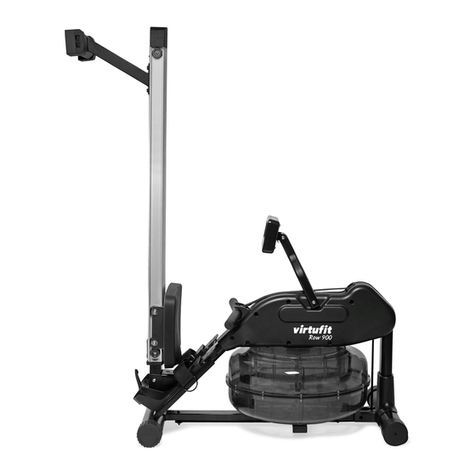
VIRTUFIT
VIRTUFIT Water Resistance Row 900 user manual
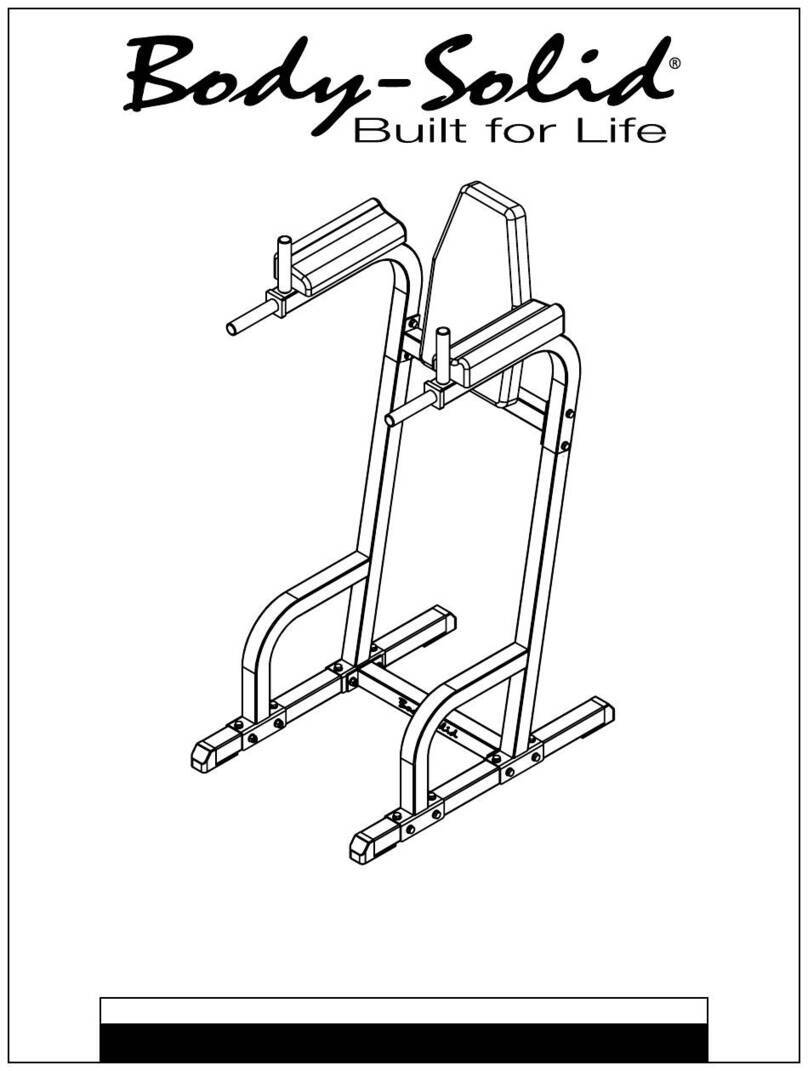
Body Solid
Body Solid GVKR60 Assembly instructions & owner's manual

ATX
ATX ATX-BPR-790 owner's manual

SUPMOGO
SUPMOGO Fitness Wearable Belt user manual

Skandika Fitness
Skandika Fitness Rower CAMBRIDGE Setup and user's manual
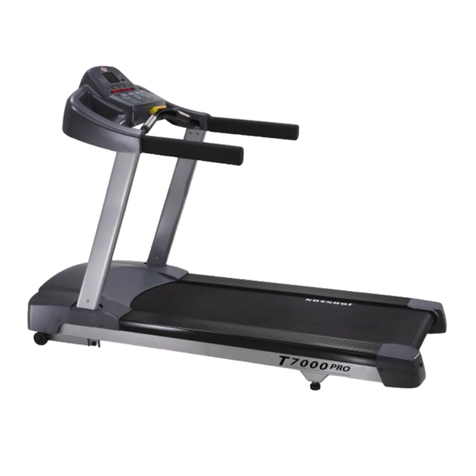
Johnson
Johnson T7000 PRO Service manual
